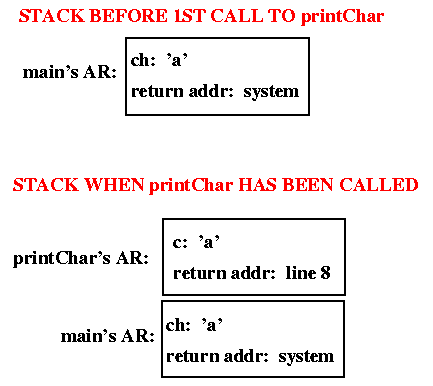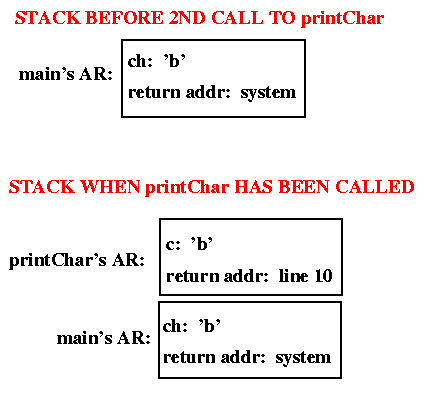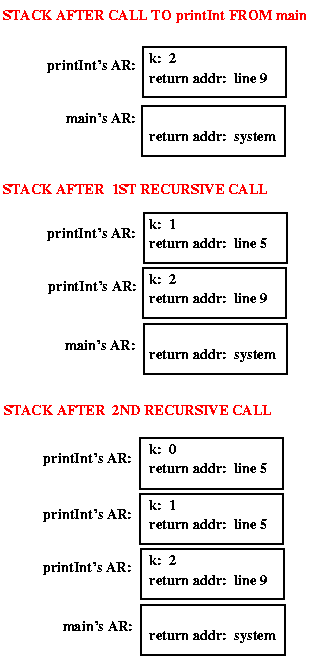
Recursion is:
A method is recursive if it can call itself, either directly:
void f() {
... f() ...
}or indirectly:
void f() {
... g() ...
}
void g() {
... f() ...
}You might wonder about the following issues:
Q: Does using recursion usually make your code faster?
A: No.
Q: Does using recursion usually use less memory?
A: No.
Q: Then why use recursion?
A: It sometimes makes your code much simpler!
One way to think about recursion:
Here's an example of a simple recursive method:
void printInt( int k ) {
1. if (k == 0) {
2. return;
3. }
4. System.out.println( k );
5. printInt( k - 1 );
6. System.out.println( "all done" );
}
If the call printInt(2) is made, three "clones" are created, as illustrated below:

The original call causes 2 to be output, and then a recursive call is made, creating a clone with k = 1. That clone executes line 1 (the if condition is false), line 4 (prints 1), and line 5 (makes another recursive call, creating a clone with k = 0). That clone just returns (goes away) because the if condition is true. The previous clone executes line 6 (the line after its "marker") then returns, and similarly for the original clone.
Now let's think about what we have to do to make sure that recursive methods work correctly. First, consider the following recursive method:
void badPrint(int k) {
System.out.println(k);
badPrint(k + 1);
}Note that a runtime error will occur when the call badPrint(2) is made (in particular, an error message like "java.lang.StackOverflowError" will be printed, and the program will stop). This is because there is no code that prevents the recursive call from being made again and again and .... and eventually the program runs out of memory (to store all the clones). This is an example of an infinite recursion. It inspires:
*** RECURSION RULE #1 ***
Here's another example; this version does have a base case, but the call badPrint2(2) will still cause an infinite recursion:
void badPrint2(int k) {
if (k < 0) {
return;
}
System.out.println(k);
badPrint2(k + 1);
}
This inspires:
*** RECURSION RULE #2 ***
TEST YOURSELF #1
Consider the method printInt, repeated below.
void printInt(int k) {
if (k == 0) {
return;
}
System.out.println(k);
printInt(k - 1);
}
Does it obey recursion rules 1 and 2? Are there calls that will lead to an infinite recursion? If yes, how could it be fixed?
This is how method calls (recursive and non-recursive) really work:
Example (no recursion):
1. void printChar (char c) {
2. System.out.print(c);
3. }
4.
5. void main ( ... ) {
6. char ch = 'a';
7. printChar(ch);
8. ch = 'b';
9. printChar(ch);
10. }
The runtime stack of activation records is shown below, first as it would be just before the first call to printChar (just after line 6) and then as it would be while printChar is executing (lines 1 - 3). Note that the return address stored in printChar's AR is the place in main's code where execution will resume when printChar returns.

When the first call to printChar returns, the top activation record is popped from the stack and the main method begins executing again at line 8. After executing the assignment at line 8, a second call to printChar is made (line 9), as illustrated below:

The two calls to printChar return to different places in main because different return addresses are stored in the ARs that are pushed onto the stack when the calls are made.
Now let's consider recursive calls:
1. void printInt( int k ) {
2. if (k <= 0) return;
3. System.out.println( k );
4. printInt( k - 1 );
5. }
6.
7. void main( ... ) {
8. printInt( 2 );
9. }
The following pictures illustrate the runtime stack as this program executes.

Note that all of the recursive calls have the same return address -- after a recursive call returns, the previous call to printInt starts executing again at line 5. In this case, there is nothing more to do at that point, so the method would, in turn, return.
Note also that each call to printInt causes the current value of k to be printed, so the output of the program is: 2 1
Now consider a slightly different version of the printInt method:
1. void printInt(int k) {
2. if (k <= 0) return;
3. printInt(k - 1);
4. System.out.println(k);
5. }
Now what is printed as a result of the call printInt(2)? Because the print statement comes after the recursive call, it is not executed until the recursive call finishes (i.e., printInt's activation record will have line 4 -- the print statement -- as its return address, so that line will be executed only after the recursive call finishes). In this case, that means that the output is: 1 2 (instead of 2 1, as it was when the print statement came before the recursive call). This leads to the following insight:
*** UNDERSTANDING RECURSION ***
TEST YOURSELF #2
void printTwoInts(int k) {
if (k == 0) {
return;
}
System.out.println("From before recursion: " + k);
printTwoInts(k - 1);
System.out.println("From after recursion: " + k);
}
What is printed as a result of the call printTwoInts(3)?
Now let's think about when it is a good idea to use recursion and why. In many cases there will be a choice: many methods can be written either with or without using recursion.
Q: Is the recursive version usually faster?
A: No -- it's usually slower (due to the overhead of maintaining the stack)
Q: Does the recursive version usually use less memory?
A: No -- it usually uses more memory (for the stack).
Q: Then why use recursion?
A: Sometimes it is much simpler to write the recursive version.
Here are a few examples where recursion makes things a little bit clearer, though in the second case, the efficiency problem makes it a bad choice.
Factorial can be defined as follows:
(Note that factorial is undefined for negative numbers.)
The first definition leads to an iterative version of factorial:
int factorial(int N) {
if (N == 0) {
return 1;
}
int tmp = N;
for (int k = N-1; k >= 1; k--) {
tmp = tmp * k;
}
return (tmp);
}
The second definition leads to a recursive version:
int factorial(int N) {
if (N == 0) {
return 1;
} else {
return (N * factorial( N-1 ));
}
}
The recursive version is
Because the recursive version causes an activation record to be pushed onto the runtime stack for every call, it is also more limited than the iterative version (it will fail, with a "stack overflow" error), for large values of N.
TEST YOURSELF #3
Question 1: Draw the runtime stack, showing the activation records that would be pushed as a result of the call factorial(3) (using the recursive version of factorial). Just show the value of N in each AR (don't worry about the return address). Also indicate the value that is returned as the result of each call.
Question 2: Recall that (mathematically) factorial is undefined for a negative number. What happens as a result of the call factorial(-1) for each of the two versions (iterative and recursive)? What do you think really should happen when the call factorial(-1) is made? How could you write the method to make that happen?
Fibonacci can be defined as follows:
Fibonacci can be programmed either using iteration or using recursion. Here are the two versions (iterative first):
// iterative version
int fib( int N ) {
int k1, k2, k3;
k1 = k2 = k3 = 1;
for (int j = 3; j <= N; j++) {
k3 = k1 + k2;
k1 = k2;
k2 = k3;
}
return k3;
}
// recursive version
int fib( int N ) {
if ((N == 1) || (N == 2)) {
return 1;
} else {
return (fib( N-1 ) + fib( N-2 ));
}
}
For fibonacci, the recursive version is:
Here's a picture of a trace of the recursive version of fibonacci, for the initial call fib(6):

Note: one reason the recursive version is so slow is that it is repeating computations. For example, fib(4) is computed twice and fib(3) is computed 3 times.
Given that the recursive version of fibonacci is slower than the iterative version, is there a good reason for using it? The answer may be yes: because the recursive solution is so much simpler, it is likely to take much less time to write, debug, and maintain. If those costs (the cost for programming time) are more important than the cost of having a slow program, then the advantages of using the recursive solution outweigh the disadvantage and you should use it! If the speed of the final code is of vital importance, then you should not use the recursive fibonacci.
So far, we've been doing all our recursion based on the value of some int parameter; e.g., for factorial, we start with some value N and each recursive call passes a smaller value (N - 1) until we get down to 0. A more common way to use recursion in programming is to base the recursion on a recursive data structure. A data structure is recursive if you can define it in terms of itself. For example, we can give a recursive definition of a string:
We can give a similar, recursive definition of a linked list:
Below are two methods that use recursive data structures; the first one prints each character of its String parameter and the second prints each value in its linked list parameter.
Example 1: Use a String parameter
printStr( String S ) {
if (S.equals("")) {
return;
}
System.out.print( S.substring(0, 1) + " " );
printStr( S.substring(1) );
}
Example 2: Use a linked list parameter
printList( Listnode<E> l ) {
if (l == null) {
return;
}
System.out.println(l.getData());
printList(l.getNext());
}
Now suppose we want to print the values in a linked list backwards; i.e., if the list looks like this:

we want to print:
itemN itemN-1 ... item2 item1
It is easy to do this using recursion; all we have to do is swap the order of the print statement and the recursive call in the Example 2 code given above. Here's the new version:
printList(Listnode<E> llist) {
if (llist == null) {
return;
}
printList(llist.getNext());
System.out.println(llist.getData());
}
In order to print the list backwards without using recursion, you'd have to use some auxiliary data structure. For example, you could traverse the list from left to right, pushing each value into a stack, then pop the stack, printing each value. However, it's much simpler just to use recursion!
TEST YOURSELF #4
Question 1: Write a recursive method called sum with the following header:
public static int sum(Listnode<Integer> node)
Assume that node points to the first node in a linked list of Integers. The method sum should return the sum of the values in the list.
Question 2: Write a recursive method called vowels with the following header:
public static String vowels(String str)
The method vowels should return a String containing just the vowels (a, e, i, o, u) in str, in the order in which they occur in str. For example, vowels("hooligan") should return "ooia".
There are two ways to determine how much time is required for a call to a recursive method:
To reason about the time required for a call to a recursive method, you must figure out how many times total the method will be called and how much work (in terms of the problem size, N) is done on each call in addition to the recursive calls. The total time is the product of those two values.
For example, consider recursive method printInt:
public static void printInt(int k) {
if (k == 0) {
return;
}
System.out.println( k );
printInt( k - 1 );
}
It is easy to see that if printInt is first called with the value N, then a total of N+1 calls will be made (for N, N-1, N-2, ... 0). Each time printInt is called, a constant amount of work is done (to check and print the value of k) in addition to the recursive call. Therefore, the total time is O(N).
A more formal way to analyze the running time of a recursive method is to use recurrence equations. The recurrence equations for a method include an equation for the base case (or several equations if there are several base cases) and an equation for the recursive case.
For example, for the printInt method above, the recurrence equations are:
The first equation says that a problem of size 0 (i.e., when parameter k = 0) requires a constant amount of work (test k and return). The second equation says that a problem of size N (i.e., when parameter k is not 0) requires a constant amount of work (test and print k) plus the time required for solving a problem of size N-1.
In general, the recurrence equation for the recursive case will be of the following form:
The first blank is the amount of time outside the recursive call(s). In the printInt method above, that is constant, so we fill in the first blank with a 1.
The second blank is the number of recursive calls. Not the total number of recursive calls that will be made, just the number made here. In the printInt method above, there is just one recursive call, so we fill in the second blank with a 1.
The third blank is the problem size passed to the recursive call. It better be less than the current problem size, or the code will not make progress toward the base case! In our example, the problem size (the value of k) decreases by one, so we fill in the third blank with N-1.
The final equation for the recursive case is
Which is the same as the equation given above (just with an explicit "times 1"). Now consider a different version of printInt:
public static void printInt(int k) {
if (k == 0) {
return;
}
printInt(k/2);
for (int j = 0; j < k; j++) {
System.out.println(j);
}
printInt(k/2);
}
For this version, the amount of time outside of the recursive calls is proportional to the problem size, there are two recursive calls, and the problem size passed to each of those calls is half the original problem size. Therefore, the recurrence equation for this new version of printInt is
Now let's consider how to solve recurrence equations. To find the worst-case time for a problem of size N, we need to find a closed-form solution to these equations, i.e., a solution for T(N) that doesn't involve any T(...) on the right-hand side. To do that we perform three steps:
Below are those three steps for the original printInt equations, which were:
| T(0) = 1 |
| T(1) = 1 + T(0) = 1 + 1 = 2 |
| T(2) = 1 + T(1) = 1 + 2 = 3 |
| T(3) = 1 + T(2) = 1 + 3 = 4 |
Step 2: Look for a pattern and guess a solution
Step 3: Verify the guessed solution
| T(N) | = | 1 + T(N-1) | // given |
| N+1 | =?= | 1 + ((N-1)+1) | // replace T(...) on both sides with the guessed solution (N+1) in which each N is replaced by ... |
| N+1 | =?= | 1 + N - 1 + 1 | // simplify |
| N+1 | = | 1 + N | // yes the two sides are equal! |
TEST YOURSELF #5
Suppose we have the following recurrence equations:
Do the steps nexcessary to solve those equations. First, fill in the following table:
| N | T(N) |
|---|---|
| 1 | |
| 2 | |
| 4 | |
| 8 |
Next, look for a pattern and guess a solution.
Finally, verify your solution using the recursive equation.
If you like math, you may enjoy thinking about how to use mathematical induction to prove that recursive code is correct. If not, feel free to skip this section.
When using induction to prove a theorem, you need to show:
It is sometimes straightforward to use induction to prove that recursive code is correct. Let's consider how to do that for the recursive version of factorial. First we need to prove the base case: factorial(0) = 0! (which, by definition is 1). The correctness of the factorial method for N=0 is obvious from the code: when N==0 it returns 1.
Now we need to show that if factorial(k) = k!, then factorial(k+1) = (k+1)!.
Looking at the code we see that for N != 0, factorial(N) = (N)*factorial(N-1).So factorial(k+1) = (k+1)*factorial(k).
By assumption, factorial(k) = k!, so factorial(k+1) = (k+1)*(k!).
By definition, k! = k*(k-1)*(k-2)*...*3*2*1.
So (k+1)*(k!) = (k+1)*k*(k-1)*(k-2)*...*3*2*1, which is (by definition)
(k+1)!, and the proof is done.
Note that we've shown that the factorial method is correct for all values of N greater than or equal to zero (because our base case was N=0). We haven't shown anything about factorial for negative numbers.